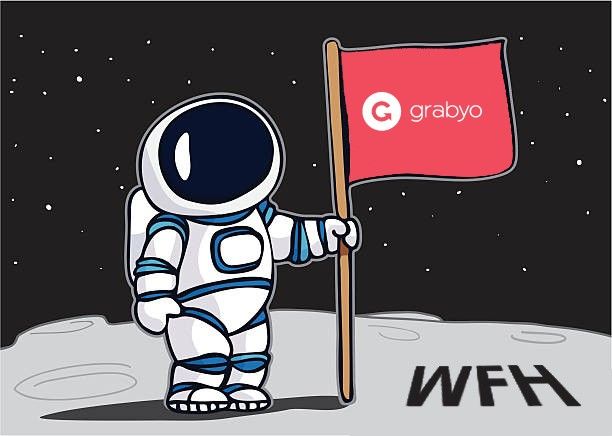Grabyo’s journey to remote working during the pandemic

It has been more than a year and a half since Grabyo decided to send everyone to work from home because of the pandemic. An unknown and challenging step for the company as our culture was built around the office until that moment.
A culture based on providing a career progression with challenges and responsibilities while having fun in our office. There was always time to focus and get stuff done but also to have a good time playing board games, occasional football games or visiting the next-door pub.
Like many companies, we started an uncharted journey where we had to understand and review our strategy and overcome different challenges to discover remote working successfully.

As soon as we started working from home, we started seeing some of the challenges that highlighted the difficulties of managing a remote team compared to managing an office-based team.
Tools stack
The first thing we did was review and decide the right set of tools we wanted to use. Every meeting would need different tools based on the requirements. It was essential to ensure our teams could continue communicating effectively without problems during various sessions like whiteboard meetings, scrum meetings, remote interviews or pair programming sessions.
If you are interested, here is our current tool set:
- Slack: Informal tool to communicate with our teammates
- Email: Formal tool to communicate with our teammates
- Google Meet: Video tool for day to day meetings
- Google Calendar: Tool to schedule appointments and events or to check our team availability
- Miro: Brainstorming and whiteboarding sessions
- Visual Studio Live: Tool for remote interviews or pair programming sessions
- Jira: Agile boards for the teams
- Confluence: Company wiki
- Donut, Kahoot!: Tools for team building
Set up formal (and informal) communication best practices
Once the tools were defined, the next step was to determine best practices for communicating internally. Then, based on the requirements, the team would choose one tool over another to communicate effectively with other members of the team and the wider business. For example, using Slack as a tool for the team to communicate or ask questions to use emails to share more critical topics was key to ensuring a transparent and non-disruptive approach in communicating with the broader team. It also helped us to reduce unnecessary meetings.
Workspace
In a difference of days, people went from having a nice workstation with multiple commodities like monitors, big desks and quiet rooms to juggling to find some space at home. During the first days, it was quite common to see people at their kitchen tables trying to find quiet areas or even a good internet connection.
The management team performed multiple surveys to the team to better understand what our employees required to work effectively but also to hear their feedback and preferences around remote working.
Finally, the company decided to provide the equipment needed for those who had difficulties working from home, and invested in keyboards, monitors, chairs, desks or even helped in improving broadband connections. In addition our headquarter offices in London were open for those who couldn’t have a space to work at home and could easily commute.
Hiring and onboarding new engineers
Going directly into a lockdown made the hiring process more difficult for all parties as candidates and interviewers had to adapt to the lack of face to face interaction. We needed to gauge the candidate’s skills and personality without meeting them IRL but at the same time guarantee an engaging and fast process.
Furthermore, once the candidate was hired, we needed to ensure the new employee had all the tools ready and felt part of the team from day one.
Onboarding a new engineer would become one of the most critical areas to focus on as we had to create a similar experience as being onboarded in the office.
As we started this process, we realised how much information there was to share. Details that are shared in person could seem meaningless, could be pretty crucial in a remote environment. For this reason, we documented as much as we could and created a task list process that would guide the new employees during the first days/weeks at Grabyo.

More documentation!
Not having quick little chats over the water cooler or coffee machine highlighted the importance of having clear and up to date documentation on projects and processes. We used to have essential conversations where decisions were made and implemented at an agile pace in the office. However, now with people working from home, we needed to ensure documentation and meeting notes were created and shared with everyone to avoid awareness gaps and misalignment.
Back in the office, it was straightforward to have random chats based on quick questions or comments that would help understand the status and progress of different tasks. However, remote working could lead to communication gaps, and we needed to ensure everyone was aligned.
Change of mindset
One of the initial concerns of the management team was whether our employees would perform like they used to do in the office. Working from home was completely new to us, and it required an exercise of trusting our teams to give them all the chance to prove they could complete the projects even while working remotely.
Keeping the Grabyo culture alive
At Grabyo, we always have been proud of the close bonds we form through the workplace. Team lunches, happy hours on Fridays, darts, board games, weekly football games and Hackathons were some social activities that we had to stop for a while. Finding alternatives would become one of the biggest challenges during the pandemic.
We had to get creative and organise activities that could bring the team together and encourage everyone’s participation during this time. Bingo, Quizzes, Sport challenges or solving a virtual murder mystery were some of the events the team organised. We even managed to save our Christmas party and host an event for the entire company using our own Grabyo Studio, Producer and Editor suite. Another way the company found to boost morale and show appreciation was by sending a gift to all employees to celebrate Easter.
Ensuring team happiness is essential to us. Part of that meant providing the proper workspace for everyone working from home, which included an employee budget for their home office and a learning budget so our employees could continue to grow and self-learn.

Final thoughts
It’s been an exciting learning process with its pros and cons, but if you create and follow proper practices, the team can make the best of it. Yet, this journey is still not finished as now with the “new normal”, we will need to continue adapting and changing our culture as going back to the office with a hybrid setup will bring new challenges.
We’re hiring!
We’re looking for talented engineers in all areas to join our team and help us to build the future of broadcast and media production.